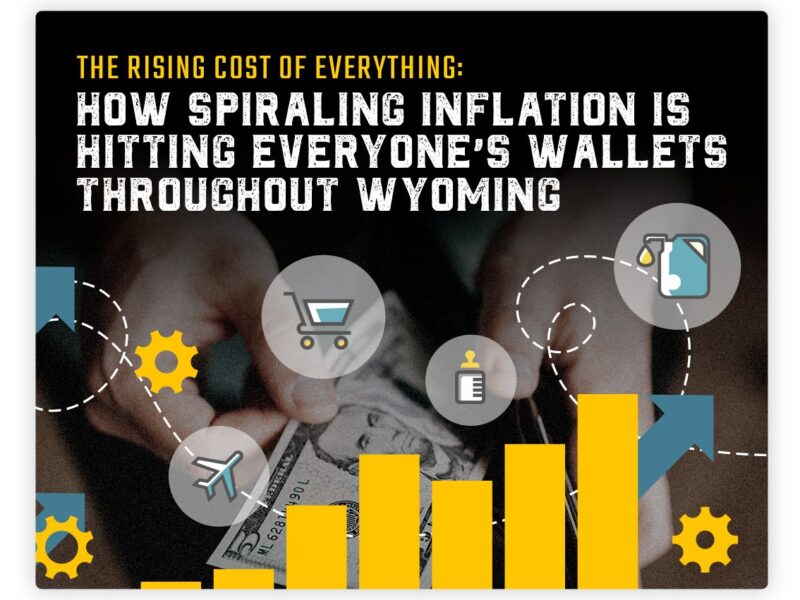THE RISING COST OF EVERYTHING: Family in Powell Scales Back Holiday Spending
Single mom trimming spending for gifts, minimizing decorations
- Published In: Other News & Features
- Last Updated: Dec 21, 2022

By Shen Wu Tan
Special to the Wyoming Truth
Sometimes, you just have to say no, even if it’s to your son when he asks you to buy a real Christmas tree.

That’s what Powell resident Dena Schwarz told her 12-year-old son, Mason, due to the financial squeeze she’s facing because of the economic downturn. This was her son’s first year as a Boy Scout, and he has been selling Christmas trees with his troop. But a higher-quality Christmas tree costs around $100—a purchase Schwarz couldn’t justify.
“I would love to support him in an activity that he is in, and I mean, he was selling the Christmas trees in the tree lot and all that,” said Schwarz, 44, who works in the service department of a credit union. “But it was just the concept of I could use that money elsewhere…. That tree goes up, and it goes down. And [then] it gets thrown out.”
So Schwarz, Mason and her 17-year-old daughter, Mattie, put up an artificial Christmas tree in their home. The family will celebrate Christmas early, as Mason and Mattie will spend the holiday with their father in Alabama.
“This year has been different for a couple of different reasons,” Schwarz said. “Everything is more expensive…Plane tickets were on top of that more expensive than normal. But with groceries and energy and gas, whether it be gasoline or natural gas, just the whole concept of everything going up means we’ve had to kind of shrink in other areas.”
Minimizing Christmas
Schwarz is not alone in curtailing her holiday spending this year.
A 2022 Deloitte holiday survey found that people plan to purchase an average of nine gifts this year, down from 16 in 2021. The survey, which was conducted in September and included about 5,000 respondents, also found that 37% of U.S. households are in a worse financial situation now compared to 2021 while 73% anticipate higher product prices this year.

Additionally, American consumer spending grew less than 2% during the first nine months of this year compared to last year, which saw a jump of over 8% after adjusting for inflation, according to the Wall Street Journal.
Schwarz is scaling back holiday spending in several ways. For starters, she slashed her gift budget by more than half. She used to set aside about $300 for presents for each of her children, spending a total of $600. About $150 of the $300 went toward a main gift. But this Christmas, the Schwarz children will each receive $100 worth of presents – a total of $200 for gifts.
Schwarz and her family also are shifting away from a typical Christmas dinner. According to Schwarz, the cost of a spiral ham at a grocery store was about $40, so their holiday meal will likely feature a chicken dish instead.
“We traditionally would have a Christmas dinner; however, I’m using the way of it’s not actually Christmas Day, so we don’t have to have Christmas dinner,” she said. “I can actually honestly say I would not spend $40 on a ham.”
The family is hanging Christmas lights inside their house—not outside—to save money on their electricity bill.
Wenlin Liu, chief economist for the Wyoming Economics Analysis Division, said widespread inflation is the top reason Americans are downsizing their holiday budgets.
“People had wage increases this year, but the wage increase still isn’t as much as the inflation,” Liu added.
Another driving factor, he noted, is the projection that the U.S. economy could fall into a recession next year. As a result, some consumers might be preparing for that while simultaneously wrestling with inflation.
However, figures show that inflation is starting to ease. A U.S. Bureau of Labor Statistics report released this month found that the overall consumer price index in November was 7.1%, a drop from 7.7% recorded in October. Despite the slight dip, the Federal Reserve on Dec. 14 raised its benchmark interest rate by a half percentage point, upping it to a range between 4.25% and 4.5% and causing stocks to slide last week. The Fed anticipates that it will maintain higher interest rates through next year.
Schwarz acknowledged experiencing a slight break from inflation recently, such as the drop in gas prices, and she is crossing her fingers for even more relief in 2023. In the meantime, she will make the most of the holiday season with what she can manage.
“I can just be mom, gift giving; I don’t have to be mom and Santa or Mrs. Claus,” Schwarz said, chuckling. “The stockings are hung, but they don’t have to be filled at this house.”













